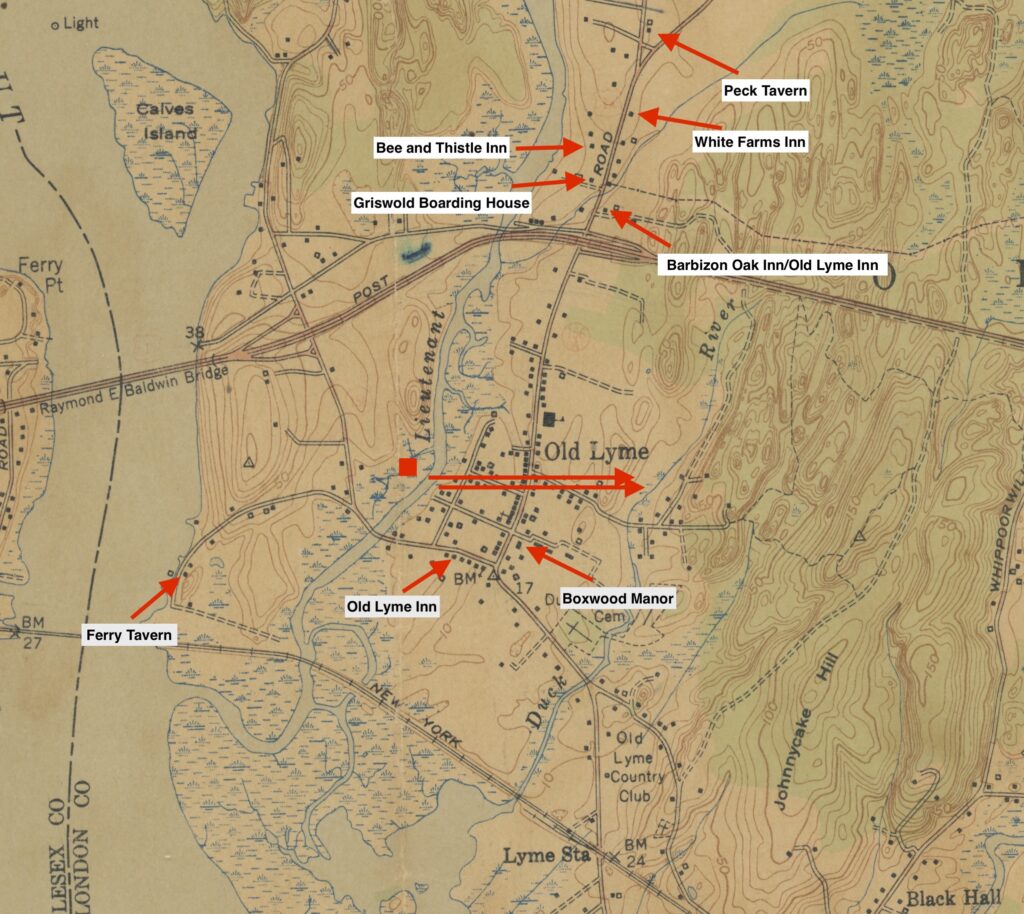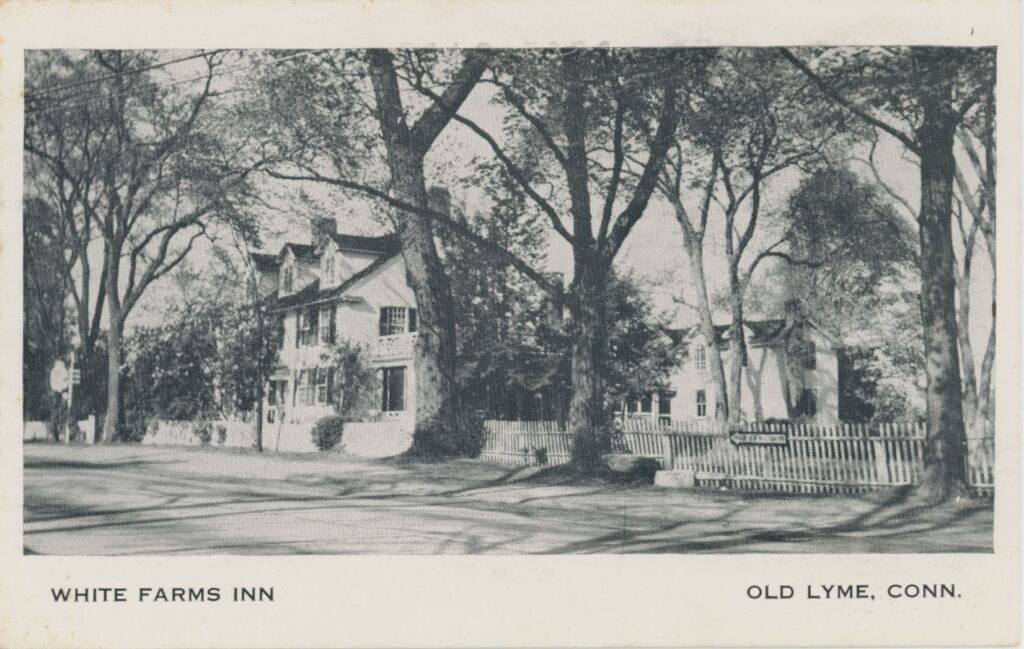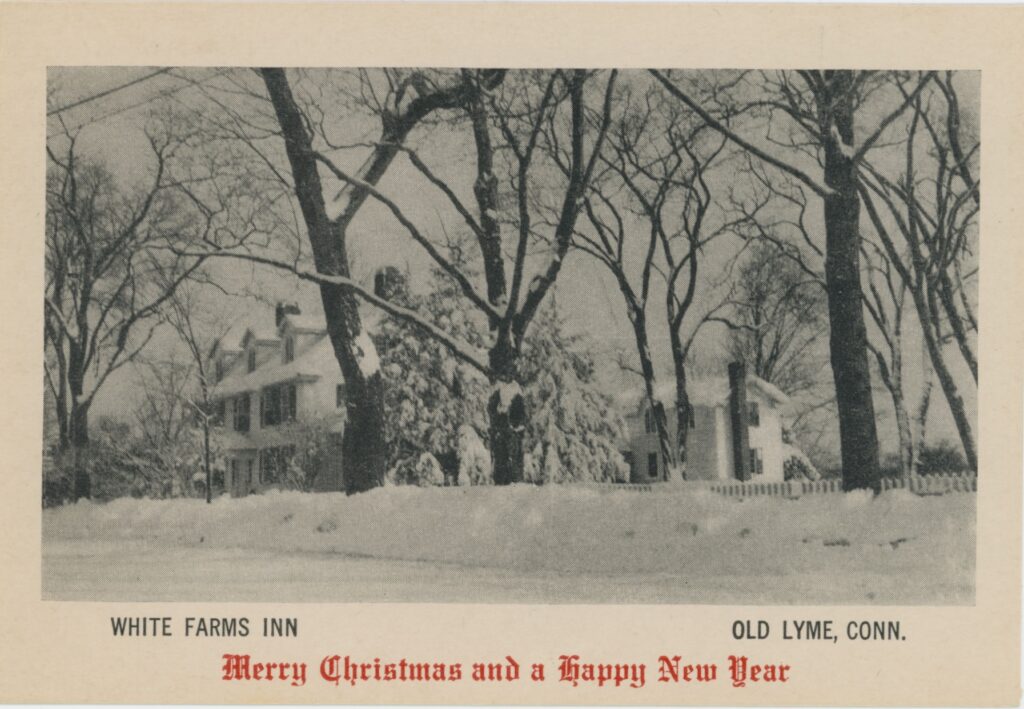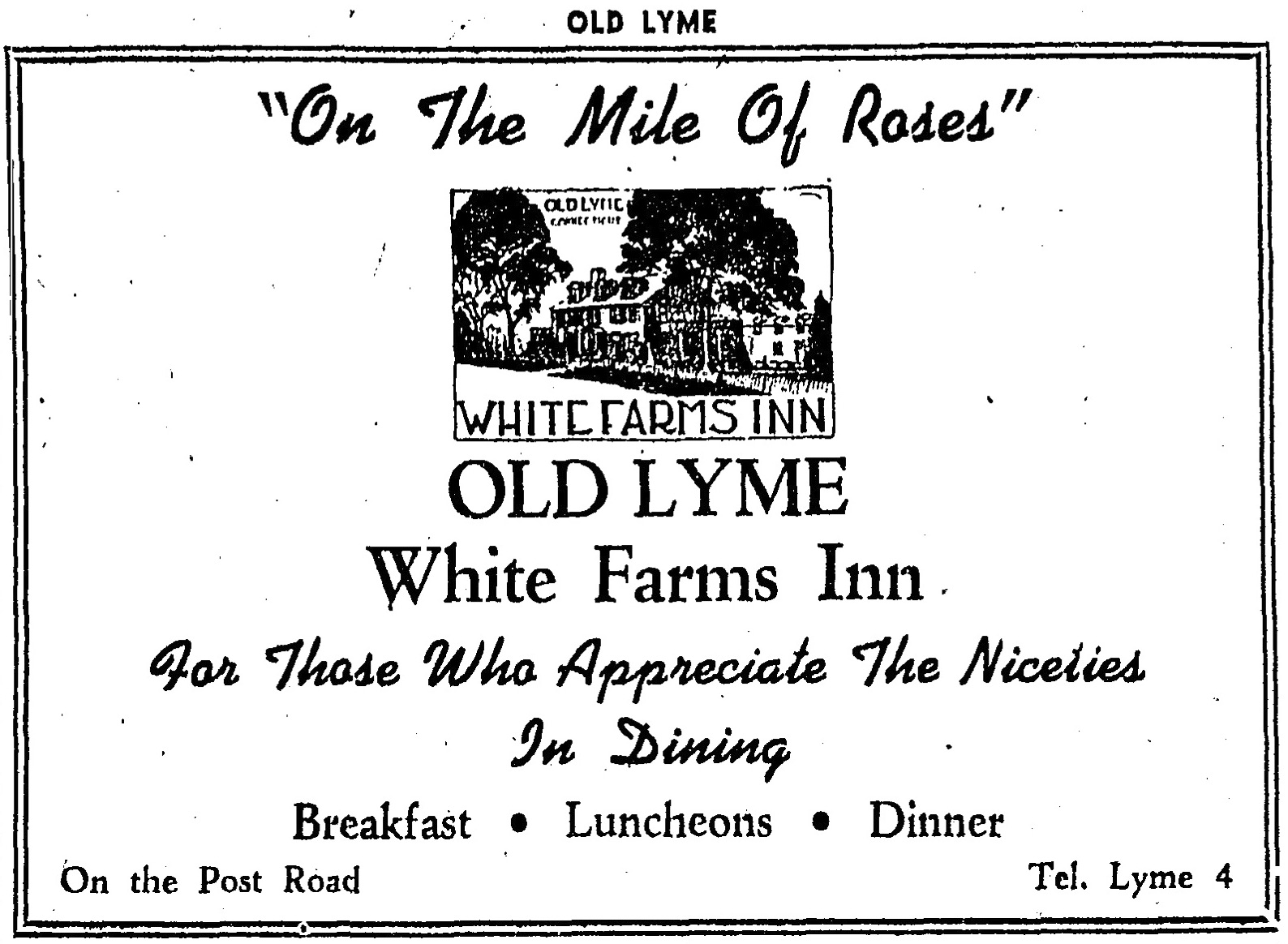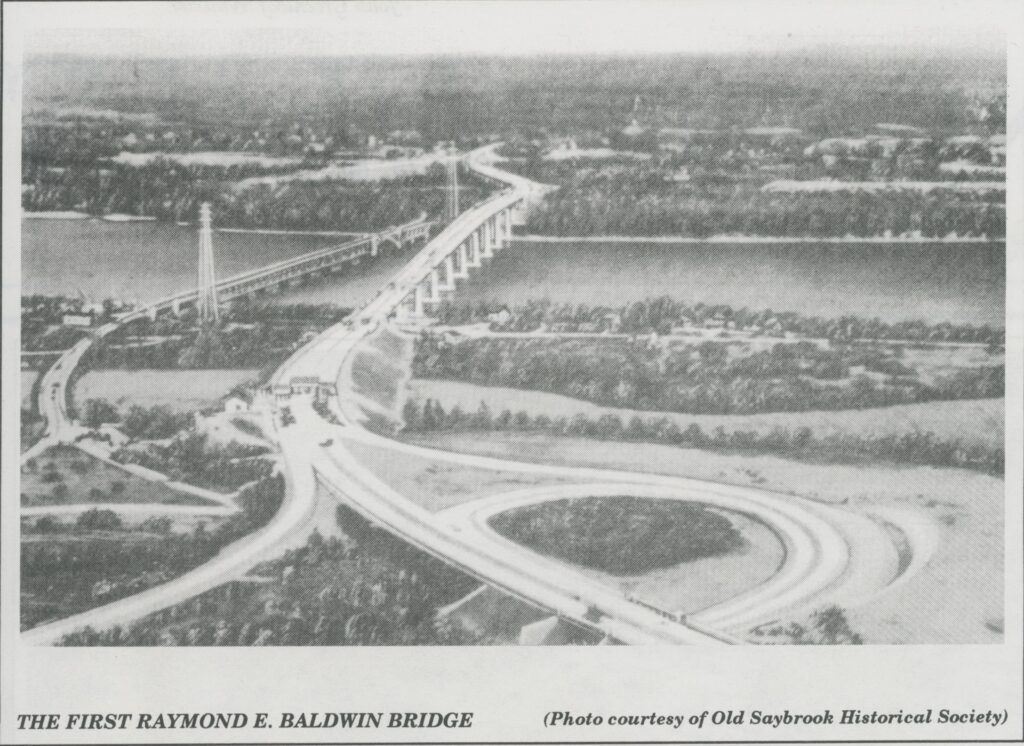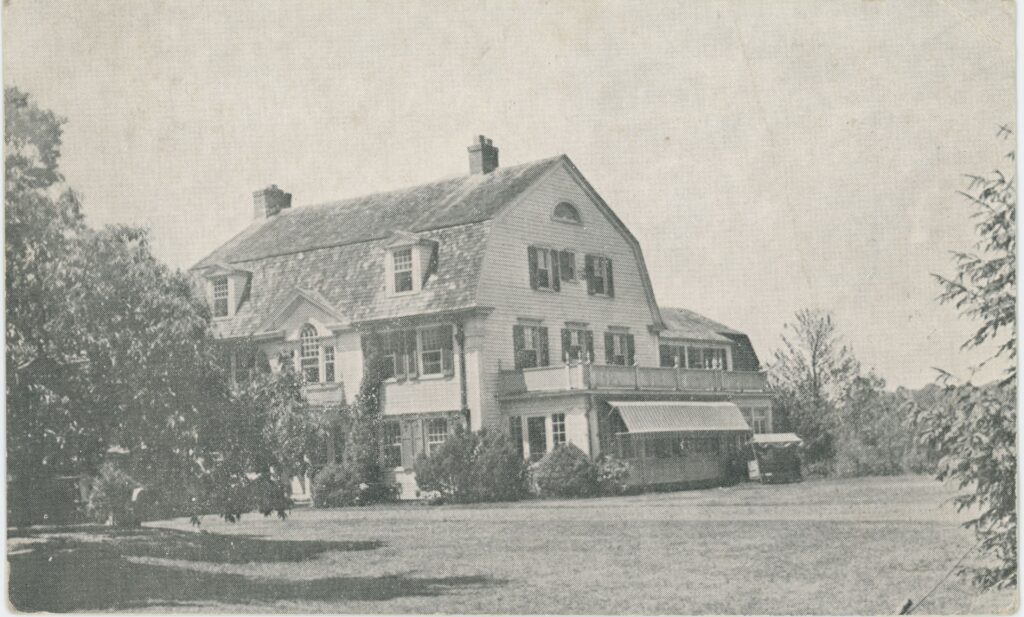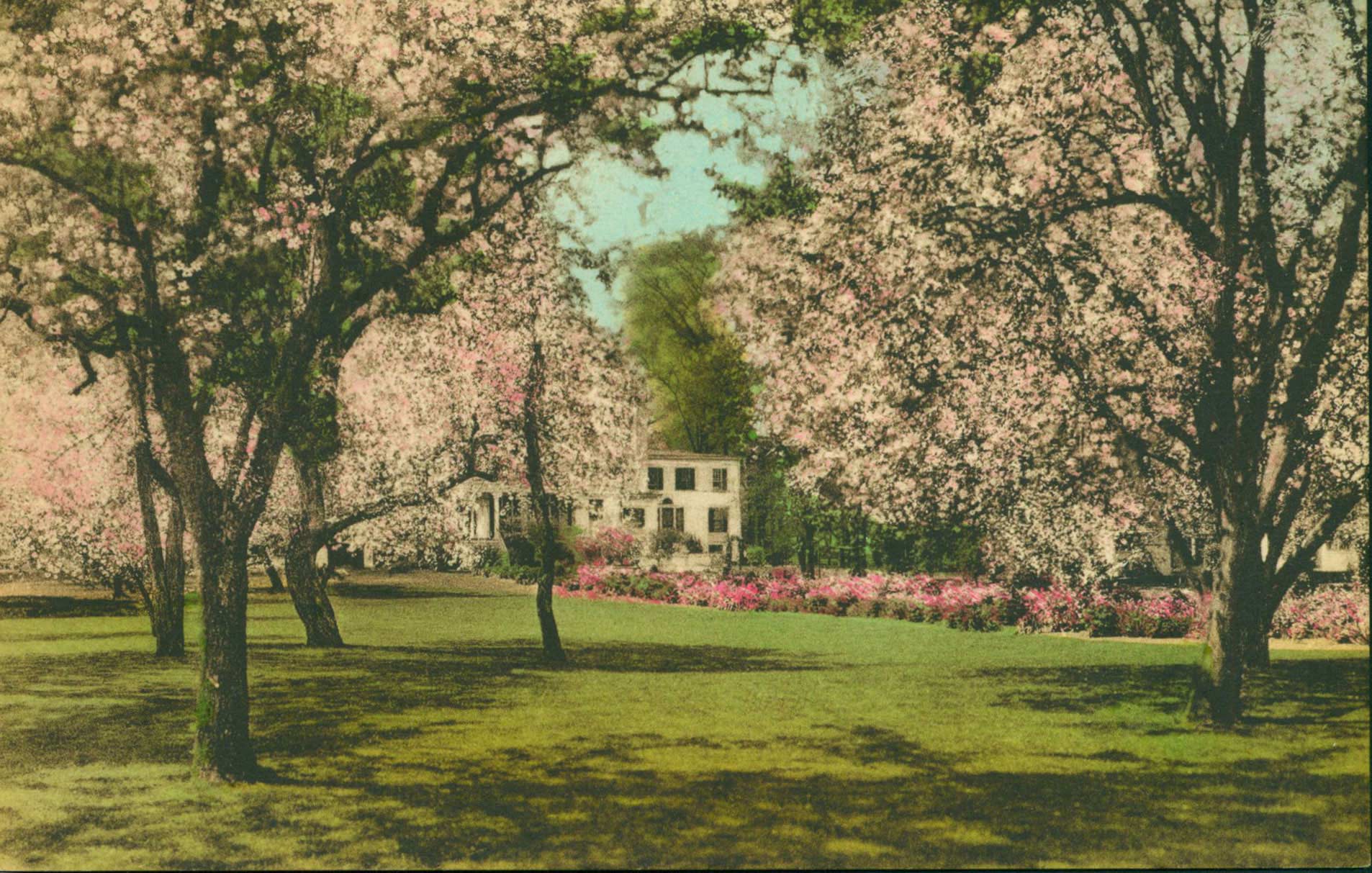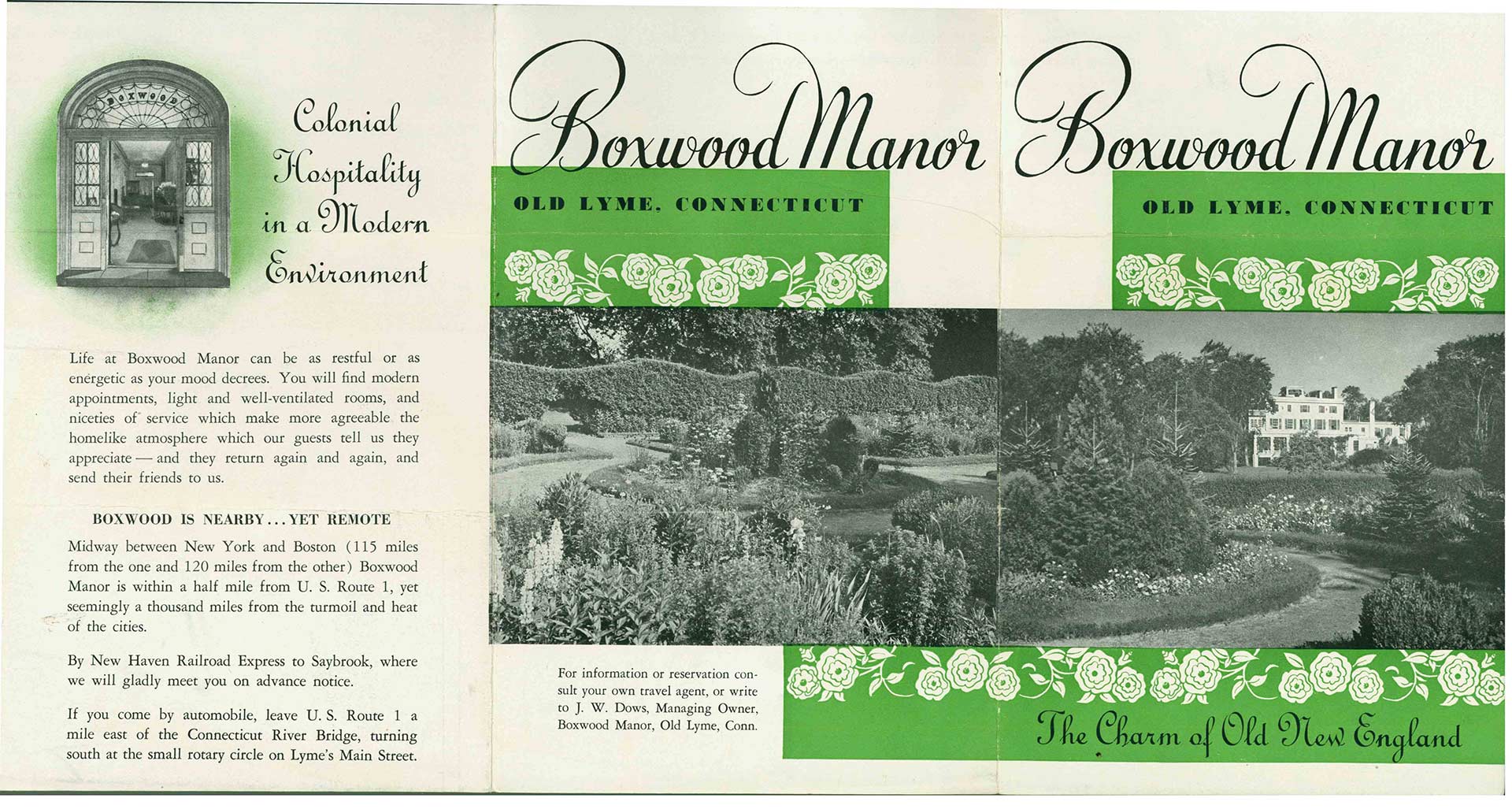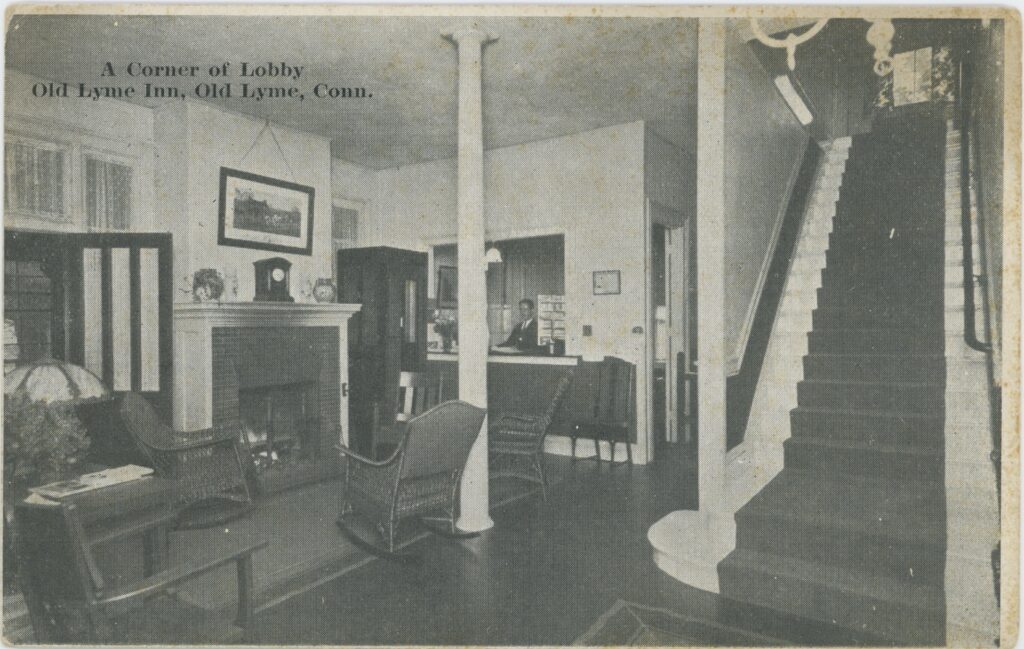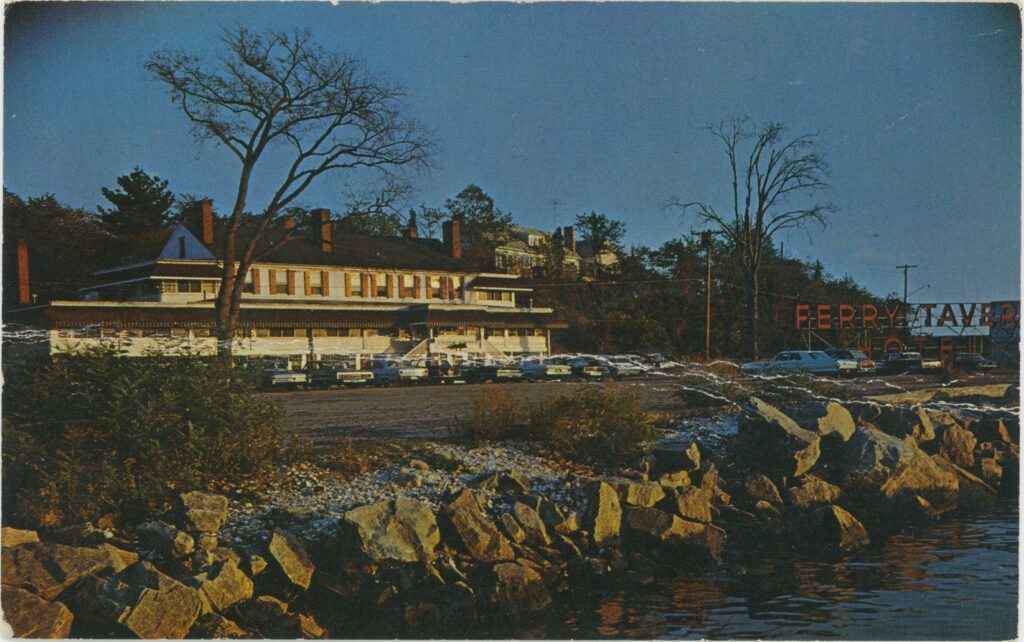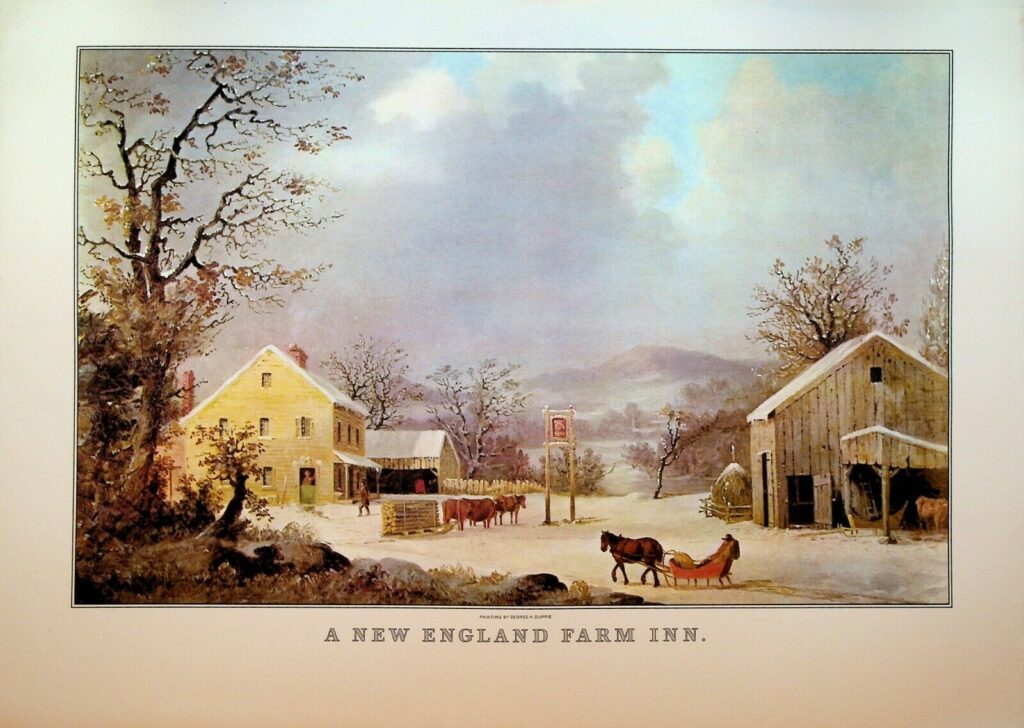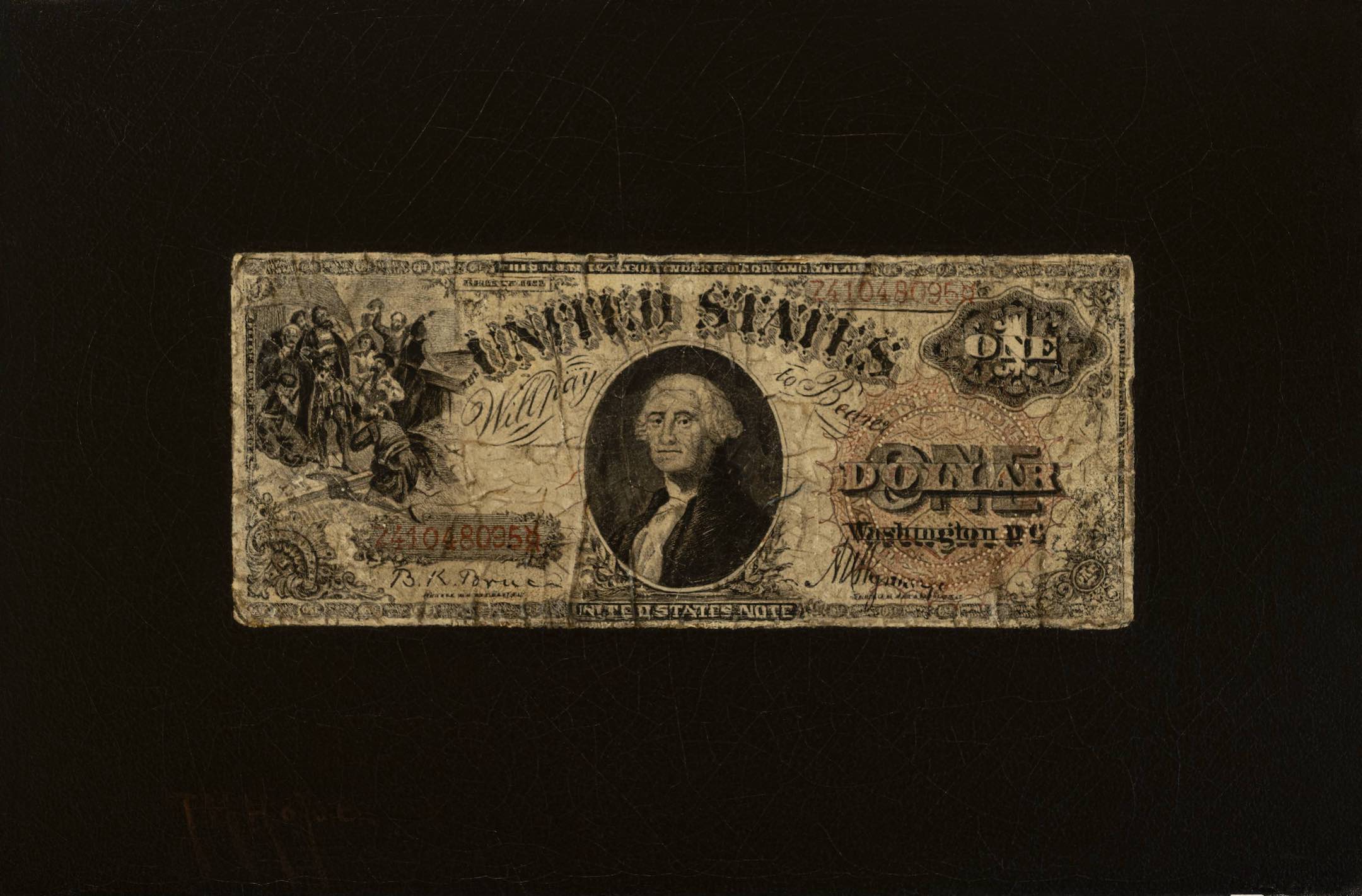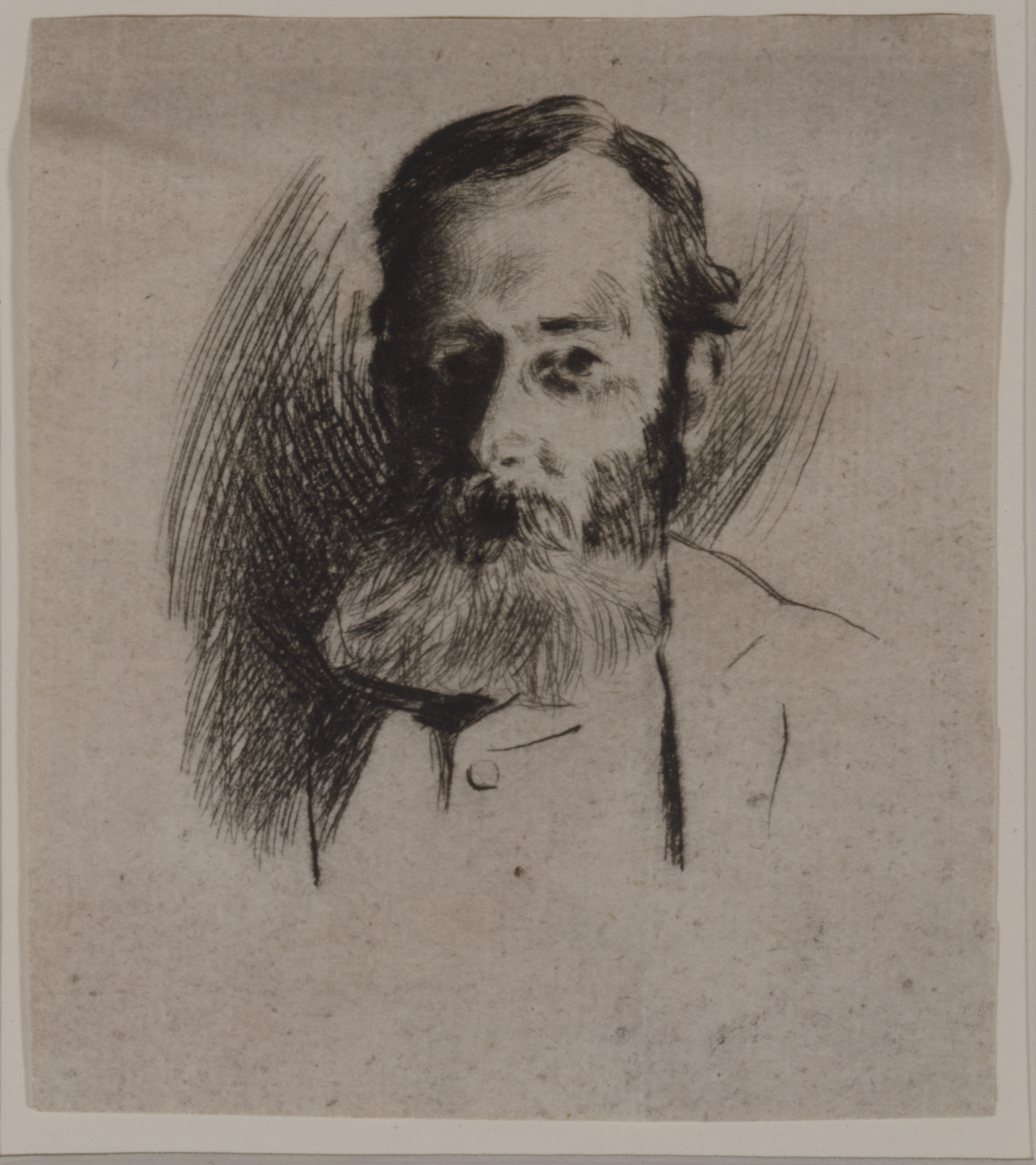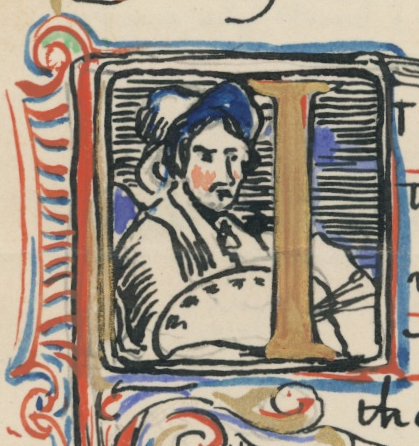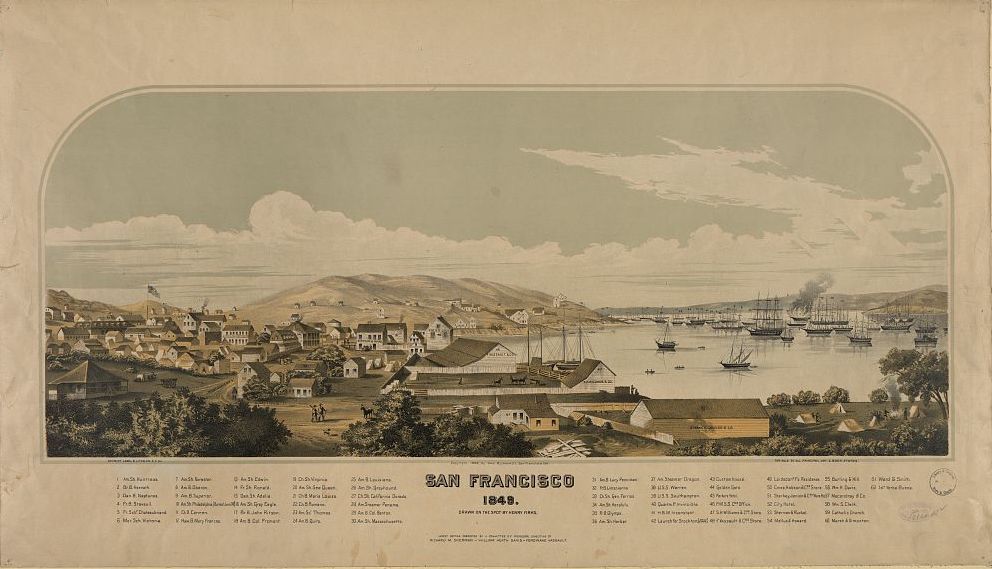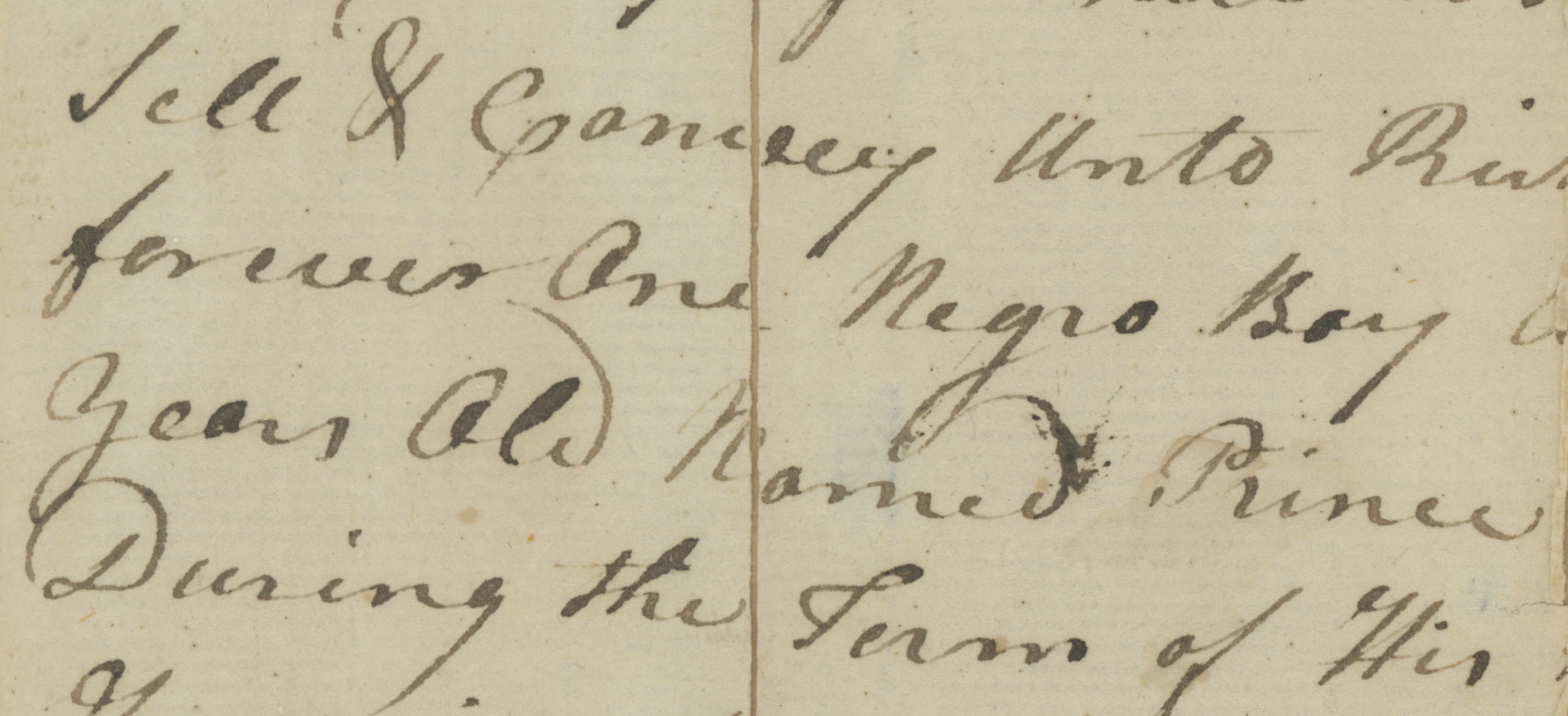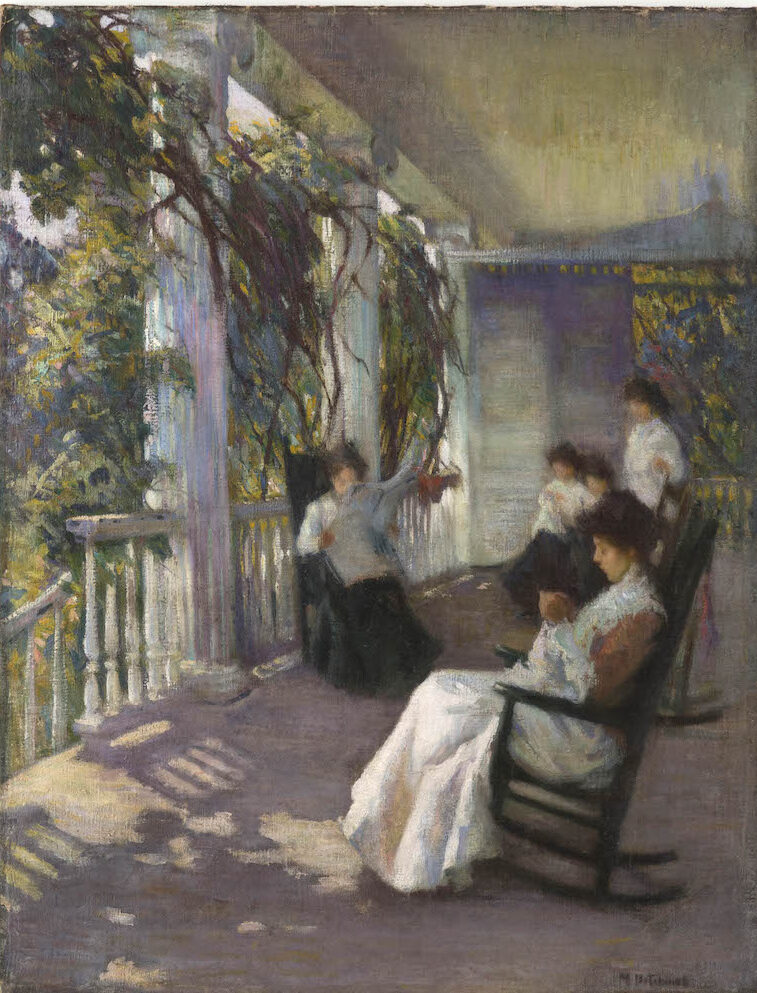
By John E. Noyes
Featured Image: Mary Bradish Titcomb, Morning at Boxwood, ca. 1910. Florence Griswold Museum, Purchase
Taverns and Inns
Mary Bradish Titcomb’s painting of women on the veranda at Boxwood Manor conveys an ambience of gentility and leisure. In the 20th century, Boxwood was one of several distinctive Old Lyme inns providing places for visitors to socialize or escape.
In the earliest days of the town originally named Lyme, taverns welcomed transients and travelers, providing lodging much less elegant than what Boxwood would later offer. Starting in 1670, town meetings appointed innkeepers who could sell alcoholic drinks to “strangers.” Revolutionary War–era accommodations included Parsons Tavern, located near the current site of the First Congregational Church, and Peck Tavern on the Boston Post Road. Parsons Tavern, converted to a residence and the home school of Phoebe Griffin Noyes in 1837, is no longer recognizable, but Peck Tavern, now a private home, still stands just north of Old Lyme’s upper green.
The 19th century saw the construction of new inns. From 1835, Bacon House at Ferry Point greeted steamboat passengers at the mouth of the Connecticut River. Forty years later, when the railroad connected the town (by then named Old Lyme) with New York and Boston, the Pierpont House Hotel opened on Ferry Road near the First Congregational Church.
Both Bacon House (rebuilt and renamed Ferry Tavern) and the Pierpont House Hotel (renamed the Old Lyme Inn) continued to thrive in the early decades of the 20th century. After 1900, Florence Griswold’s home, built in 1817, and Boxwood Manor, built in 1840, also offered seasonal room and board to visiting artists. Up in Lyme, Green Shadows opened in 1923, remaining a popular country lodge and dining spot for over 50 years.
By the middle of the 20th century, motels and vacation cottages had become popular in Old Lyme, by then easily accessible by car. Tourists could rent cabins on Rogers Lake and eat at the nearby Lake Breeze Inn. Old Lyme’s beach communities featured rental cottages and motels. Closer to the center of Old Lyme, several elegant inns welcomed visitors.
United States Geological Survey Map of Old Lyme from 1951 annotated to show locations of the inns. Lyme Historical Society Archives [LHSA] at the Florence Griswold Museum
Adapting Historic Homes
Six distinctive inns and hotels occupied buildings of historic note along Lyme Street and Ferry Road in the mid 20th century. White Farms Inn, the Bee and Thistle Inn, the Barbizon Oak Inn, and Boxwood Manor were located on Lyme Street, while on Ferry Road the Old Lyme Inn and Ferry Tavern continued to offer meals and accommodations. Each of the four Lyme Street inns had been established in an historic house during the 20th century, joining the two 19th-century Ferry Road establishments. All six remained popular for a decade or two after World War II, but by early 1971 only the Bee and Thistle Inn was still open. Today, the Bee and Thistle has closed its doors, while the “new” Old Lyme Inn, a successor to the Barbizon Oak Inn, continues Old Lyme’s tradition of welcoming visitors to historic inns.
White Farms Inn
White Farms Inn, situated in a large house on Lyme Street built about 1814 by Capt. Joseph Noyes, operated only for a few years in the 1940s and 1950s. In the late 19th and early 20th centuries, Noyes’s great-grandson Judge Walter C. Noyes, the first President of the Lyme Art Association, lived in the house, part of a 230-acre farm. After he died in 1926, his wife and daughters moved elsewhere, renting the property to a boarding school, the Madison Military Academy, from 1939 until the mid 1940s.[1] The property next became an inn.
Postcard, White Farms Inn. Lyme Historical Society Archives [LHSA] at the Florence Griswold Museum
An ad in the July 2, 1945, Hartford Courant announced that White Farms Inn would “open soon” and was taking reservations.[2] The Noyes heirs initially leased out the inn, probably run by William Wood Leonard, to whom they sold the 230-acre property in 1949.[3] Leonard then subdivided the former Noyes farm and sold off parcels, retaining for himself six acres that included the house, by then established as White Farms Inn.[4]
White Farms Inn was open year-round. Postcard, White Farms Inn in winter. Lyme Historical Society Archives [LHSA] at the Florence Griswold Museum
White Farms Inn advertisement, Hartford Courant, June 30, 1947, p. 6
The inn advertised “rooms” and “home-cooked meals.”[5] The well-respected Duncan Hines travel guidebook for 1953 described White Farms Inn – Hines’s only listing for Lyme or Old Lyme – as “[o]pen all year, every day … No specialties but just plain foods prepared in season, and homemade pastry.” Breakfasts were priced at 75 cents to $1.25, lunches at $1.65 to $2.50, and dinners at $1.75 to $2.50.[6] Social notes published in the Hartford Courant in 1953 noted the “delightful” drive to this “charming” Old Lyme inn and recommended the “Filet of Sole in Casserole with Wine Sauce,” fresh blueberry pie, and peach ice cream cake.[7]
1948 Baldwin Bridge, with 1911 highway drawbridge. Main Street News
The 1945 opening of White Farms Inn coincided with the end of World War II. The tourism industry grew as a sense of optimism and prosperity prevailed in much of the United States, and Old Lyme’s beaches, scenic beauty, and cultural and artistic heritage attracted visitors. Travel along the Connecticut shoreline soon became easier: in 1948, a four-lane highway bridge – two lanes in each direction – replaced the 1911 two-lane highway drawbridge across the Connecticut River between Old Saybrook and Old Lyme.[8] Planning for the Connecticut Turnpike began in the early 1950s;[9] that highway opened in 1958.
Facing competition from other local inns, White Farms Inn did not long survive. Leonard sold it in 1954,[10] and by July 1955, the property was again for sale, with real estate ads then noting that the former inn was “now used as a private residence.”[11] Margaret Brown, President of the Florence Griswold Museum and the Lyme Historical Society from 1968 to 1974, purchased the former White Farms Inn in 1957 and extensively remodeled it. The house remains today a stately private residence.
Bee and Thistle Inn
Postcard, Bee and Thistle Inn. Lyme Historical Society Archives [LHSA] at the Florence Griswold Museum
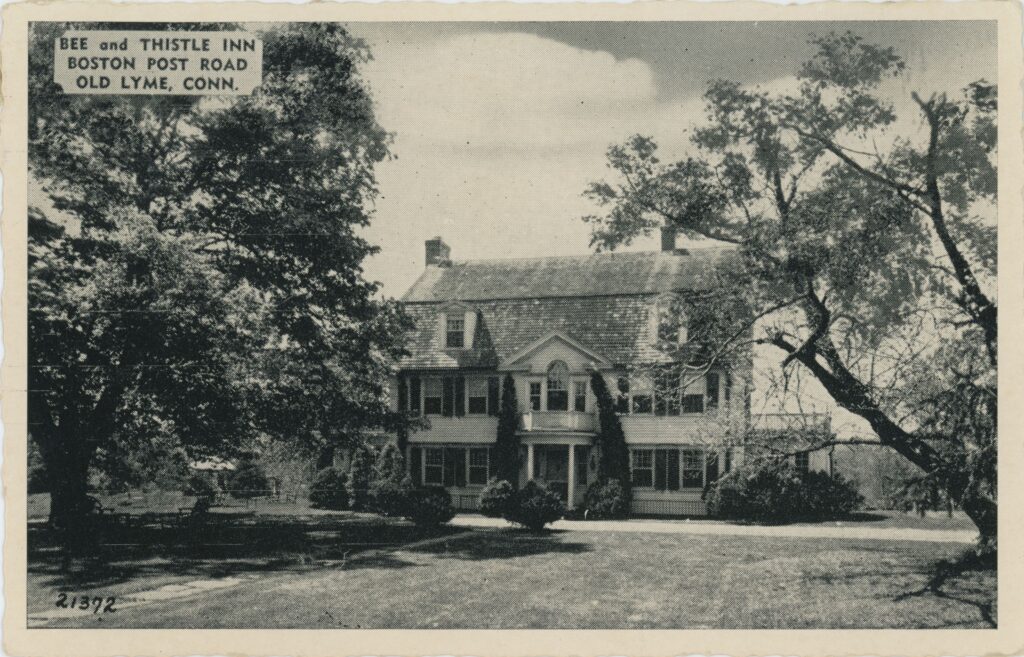
Postcard of Bee and Thistle Inn, mailed Sept. 3, 1941, with “For Those Who Like Good Food” printed on the reverse. Lyme Historical Society Archives [LHSA] at the Florence Griswold Museum
The Bee and Thistle Inn on the west side of Lyme Street predated the nearby White Farms Inn by only a few years. In the 1930s, Henrietta Greenleaf (Linsley) began renting the Bee and Thistle property, a private residence built as the home of Judge William Noyes in the late 18th century. She turned her home into an inn on the advice of her friend, the famous silent screen actress Elsie Ferguson, and then purchased the property in 1941.[12] Two years later, the Bee and Thistle advertised vacation lodging from $6.00 a day, a price that included “delectable meals.”[13] Some visitors stayed for the full summer, and the inn became known for elegant dining and its scenic location on the Lieutenant River.
The Bee and Thistle operated for about 80 years. In 2020, the Connecticut Audubon Society purchased the inn to house its Roger Tory Peterson Estuary Center, a transformation that provides opportunities for new types of social interaction and collaboration.[14]
Barbizon Oak Inn
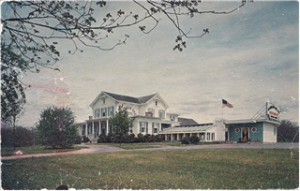 Postcard, Barbizon Oak Inn, courtesy of the Old Lyme Inn
Postcard, Barbizon Oak Inn, courtesy of the Old Lyme Inn
The Barbizon Oak Inn opened across the street from the Lyme Art Association, just as the nearby White Farms Inn was closing its doors. The Barbizon Oak occupied a house built by Capt. Daniel Chadwick in the mid 19th century for his older daughter; the house originally sat on a 400-acre farm.
Barbizon Oak Inn advertisement, Hartford Courant, July 24, 1956, p. 20
Named for the Barbizon school of painters and for a centuries-old oak tree on the property, the Barbizon Oak Inn offered a more active social scene than either White Farms or the Bee and Thistle. After the historic house was expanded to accommodate a restaurant, the Barbizon Oak advertised dining in its Starlight Terrace Room, full air conditioning, private baths in each room, a cocktail lounge with nightly music, and, by 1956, a summer playhouse.[15] The inn, which later featured the Elegante Restaurant, was damaged by fire in 1965.
The Barbizon Oak was then sold and renovated. Renamed the Old Lyme Inn (not to be confused with the former Old Lyme Inn on Ferry Road, highlighted below), it reopened in 1976 under the ownership of Diana Atwood. Today the Old Lyme Inn offers historic charm, “contemporary New England” fare, lodging, and entertainment at its renowned Side Door Jazz Club.
Boxwood Manor
Postcard, Boxwood Manor. Lyme Historical Society Archives [LHSA] at the Florence Griswold Museum
Boxwood Manor, Apple Blossoms; postcard. Lyme Historical Society Archives [LHSA] at the Florence Griswold Museum
Boxwood Manor, located just northeast of the First Congregational Church, was built in 1840 as a private mansion for the shipping magnate Richard Sill Griswold. His son Richard Sill Griswold, Jr., who moved to Old Lyme after retiring from the brass manufacturing business in Waterbury, expanded the stately residence. He added a third floor, enlarged the north wing, built a greenhouse, and planted graceful flower and shrub gardens delineated by boxwood hedges. Griswold’s wife Rosa Brown Griswold established the Boxwood School for Girls, which operated from 1890 until her death in 1907.[16]
Even before the school closed, summer art students and Lyme Art Colony artists rented rooms at Boxwood. Other guests – some distinguished, such as Woodrow Wilson, then president of Princeton University – summered there. Numerous artists captured on canvas Boxwood’s rear gardens, vine-draped veranda, and lavish interior.
Boxwood Manor Brochure. Lyme Historical Society Archives [LHSA] at the Florence Griswold Museum
James J. Carroll bought Boxwood Manor in 1946,[17] converting what had been an elegant summer hotel into a year-round one. When Boxwood reopened under Carroll’s management, he charged $35.00 for a week’s room and board.[18]
Boxwood Manor closed in 1958, and Dr. Matthew Griswold, along with his son and daughter, bought the 15-acre property a year later.[19] Dr. Griswold extensively renovated the house and grounds, turning the hotel and outbuildings into 19 apartments and opening a restaurant there.[20] The apartments, ranging in size from one to six rooms, attracted wealthy retirees.[21] After the Griswold family sold Boxwood in 1975,[22] it was converted into condominiums, the property’s present use.
Old Lyme Inn
In 1872, William Noyes Ely, Charles Ludington, George Selden Huntington, and others formed a group to build the Pierpont House Hotel on Ferry Road just west of the First Congregational Church. A new owner, Herbert Caulkins, changed the name of the establishment to the Old Lyme Inn in 1900.[23]
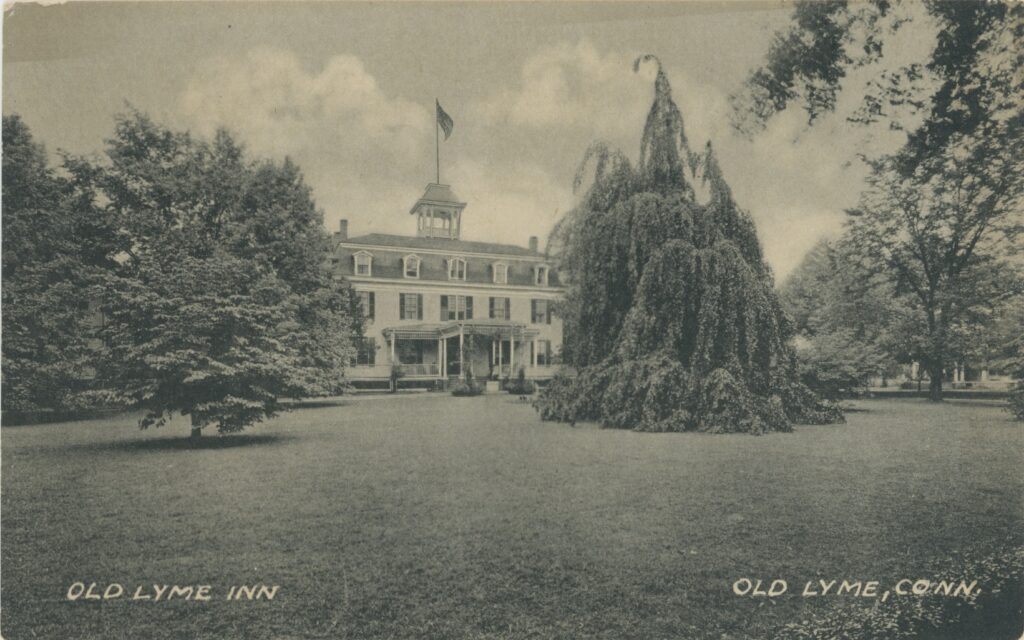 Postcard, Old Lyme Inn. Lyme Historical Society Archives [LHSA] at the Florence Griswold Museum
Postcard, Old Lyme Inn. Lyme Historical Society Archives [LHSA] at the Florence Griswold Museum
Postcard, A corner of lobby, Old Lyme Inn. Lyme Historical Society Archives [LHSA] at the Florence Griswold Museum
The fashionable hotel and its annex could accommodate 65 guests. The attractive grounds of the Old Lyme Inn featured a stunning beech tree and Japanese dogwoods. As at the Bee and Thistle Inn and Boxwood Manor, some guests stayed for the entire summer, and many returned to the Old Lyme Inn year after year. An inn brochure highlighted local leisure attractions: “Bathing, Boating, Motion Pictures, Summer Stock, Golf, Fishing, Drives, Art Colony, Churches.”[24]
The Old Lyme Inn operated through the 1960s, but was demolished in 1970. Today, the Lyme Regis condominiums occupy the site.
Ferry Tavern
Matthew Bacon built the inn called Bacon House in 1835, reportedly using bricks that had served as ballast for colonial trading ships.[25] The hotel stood at the end of Ferry Road near a cluster of wharfs and warehouses at the mouth of the Connecticut River, welcoming passengers on the New York to Hartford steamship line, as well as travelers crossing the river by ferry.
Bacon House later provided rustic accommodations for hunters and anglers. By the 1920s, it had been expanded and renamed Ferry Tavern, which catered to a clientele less genteel than that of the Old Lyme Inn. Ferry Tavern became known as a place where one could gamble or, during Prohibition, buy liquor; “[e]ven more unsavory activities were rumored.”[26] Damaged by the 1938 hurricane, Ferry Tavern stood vacant for eight years.
Postcard, Ferry Tavern Hotel, LHSA.
In 1946, James and Joseph Viveiros bought and restored the century-old hotel. Ferry Tavern soon enjoyed wide popularity, and on many nights served over 1,000 dinners.[27] In 1957, Life magazine listed the hotel as among “the best in American roadside inns,” noted for its “superb” food.[28] Ferry Tavern was destroyed by fire in 1971.
Transitions
In the middle of the 20th century, the six inns profiled here had reputations as distinctive gathering spots for celebrations, meetings, vacations, and meals with families and friends. Summer lodgers reconnected with friends from previous stays. The Barbizon Oak and Ferry Tavern provided lively atmospheres; White Farms, the Bee and Thistle, Boxwood Manor, and the Old Lyme Inn offered quiet venues for visitors escaping the hustle and bustle of cities or seeking respite from their busy routines.
Currier & Ives, after George H. Durrie, A New England Farm Inn. Reproduced in a Travelers’ Insurance calendar, 1972
The individual character of these inns and hotels enhanced their appeal. For some, the historic lodgings evoked an idealized American past, as depicted in Currier & Ives prints that also enjoyed renewed popularity during the heyday of these 20th-century inns.
But the history of Old Lyme’s inns also includes a dark side. An illicit affair at one colonial inn led to a court fine for lewd and lascivious conduct.[29] Not only was Ferry Tavern the site of illegal activities in the early 20th century, but a murder at Boxwood Manor shocked the town in 1943.[30]
In the years immediately after World War II, the increased ease of automobile travel, a solid economy, and an upbeat national mood supported the restaurants and inns that flourished in Old Lyme. But almost all of the local hotels had disappeared within a few decades. The cost of upkeep and renovations, as well as labor and supplies, rose significantly. Few visitors could afford the time or money to spend a full summer at an inn near the shore, and those with means increasingly preferred owning a vacation home. Motels proved more convenient lodging for many.
Today, the “new” Old Lyme Inn and one bed and breakfast establishment still offer historic charm, but the heyday of local hotels has passed. Indeed, few remember all the various inns that once welcomed visitors on Lyme Street and Ferry Road, whose many transitions remind us that change is a constant.
Thanks to Carolyn Wakeman, Amy Kurtz Lansing, and Mell Scalzi for their suggestions and assistance with images.
[1] “Military Academy Leases Property in Old Lyme,” Hartford Courant, June 2, 1939.
[2] Hartford Courant, July 2, 1945, p. 12.
[3] Executrix and quitclaim deeds from Estate of Walter Chadwick Noyes, Louella Noyes, Marion Armstrong Noyes, Ruth Brewster Noyes Stevenson, and Catherine Chadwick Noyes Lee to William Wood Leonard, Feb. 22, 1949, Old Lyme Land Records (OLLR) 46:477, 478.
[4] Warranty deed from White Farms Estates, Inc. to William Wood Leonard, Nov. 27, 1953, OLLR 52:576; OLLR Map # 1234. While dividing up the Noyes farm, Leonard operated through White Farms Estates, an entity he created and headed.
[5] Postcard of White Farms Inn, reverse, Lyme Historical Society Archives (LHSA).
[6] Duncan Hines, Adventures in Good Eating, 1953 Book: Good Eating Places Along the Highways and in Cities of America (Lexington, KY: Adventures in Good Eating, Inc., 1952), p. 72, available at https://babel.hathitrust.org/cgi/pt?id=inu.32000001278839&view=1up&seq=5&skin=2021.
[7] Hartford Courant, Aug. 1, 1953, p. 7, and Oct. 10, 1953, p. 6.
[8] See Ian Hubbard, Crossings: Three Centuries from Ferry Boasts to the New Baldwin Bridge (Lyme, CT: Greenwich Publishing Group, Inc., 1993), pp. 22-28.
[9] See Connecticut Public Act No. 411 (1953).
[10] Warranty deed from William Wood Leonard to Edith C. Lagreze, Apr. 1, 1954, OLLR 54:54.
[11] Hartford Courant, July 15, 1955, p. 33.
[12] Warranty deed from Daniel B. Hodgson to Henrietta Greenleaf, Oct. 17, 1941, OLLR 37:177.
[13] Hartford Courant, Aug. 29, 1943, p. 47.
[14] OLLR 439:1083.
[15] Hartford Courant, July 31, 1954, p. 3; “New Management is Announced at Barbizon Oak Inn,” ibid., Aug. 24, 1955, p. 10; “Old Lyme to Have Own Summer Theater,” ibid., Nov. 30, 1955, p. 13; Ibid., June 1, 1956, p. 11; Ibid., July 24, 1956, p. 14.
[16] Biographical Review: Containing Life Sketches of Leading Citizens of New London County Connecticut (Boston: Biographical Review Publishing, 1898), vol. 26, p. 37, LHSA.
[17] Warranty deed from Joseph W. Dows to James J. Carroll, Apr. 10, 1946, OLLR 42:97.
[18] Charlotte Ryerson, “Inns Have Been Traditional Part of Old Lyme’s Charm and History,” The Gazette, July 6, 1978, pp. 5, 25, LHSA, Box Clippings F-L, Folder 28.
[19] Warranty deed from James J. Carroll to Matthew Griswold, Matthew Griswold, Jr., and Jennifer G. Smith, Jan. 16, 1949, OLLR 64:6; and see Agreement for sale, James J. Carroll and Matthew Griswold, Oct. 28, 1958, OLLR 63:309.
[20] “Boxwood, the Pink-bricked Lady of Old Lyme, Prepares for Yet Another Change,” Old Saybrook Pictorial, Nov. 6, 1973, p. 38, LHSA, Box Clippings A-E, Folder 20.
[21] Noelle Mercanton, “Retired Persons Enjoy All the Comforts of Old Mansion; Couples Prefer Home Without Cares,” New York Times, Aug. 8, 1961, p. 35, LHSA, Box Clippings A-E, Folder 20.
[22] Warranty deed from Matthew Griswold, Matthew Griswold, Jr., and Jennifer Hillhouse to Francis P. and Marie A. McTigue, Oct. 29, 1975, OLLR 122:235.
[23] Old Saybrook Pictorial, July 1, 1970, LHSA, Box Clippings F-L, Folder 28.
[24] Ryerson, op. cit., p. 24.
[25] David Holahan and Chip Bates, “Ferry Tavern Saga Recounts Suspense, Drama of Decade: Part I – The Fire,” Gazette [Old Lyme, CT], Jan. 25, 1979, pp. 1, 13, LHSA, Box Clippings F-L, Folder 28.
[26] Chip Bates and David Holahan, “The Ferry Tavern – Part II,” Gazette [Old Lyme, CT], LHSA, Box Clippings F-L, Folder 28.
[27] Charles Stannard, “Fire Ended Century’s Worth of Fine Wining, Dining,” Hartford Courant, Sept. 14, 1999, p. B1.
[28] “Roadside Inns and Their Fine Food,” Life, July 1, 1957, pp. 66, 73, available at https://books.google.com/books?id=ID8EAAAAMBAJ&lpg=PA73&dq=ferry%20tavern&pg=PA73#v=onepage&q=ferry%20tavern&f=true
[29] See Carolyn Wakeman, “Strangers in Early Lyme,” Florence Griswold Museum History Blog, May 10, 2021, https://staging.florencegriswoldmuseum.org/glimpses-strangers-in-early-lyme/.
[30] See Stan Matthews, “Delphine Bertrand,” National Registry of Exonerations, https://www.law.umich.edu/special/exoneration/Pages/casedetailpre1989.aspx?caseid=17.

